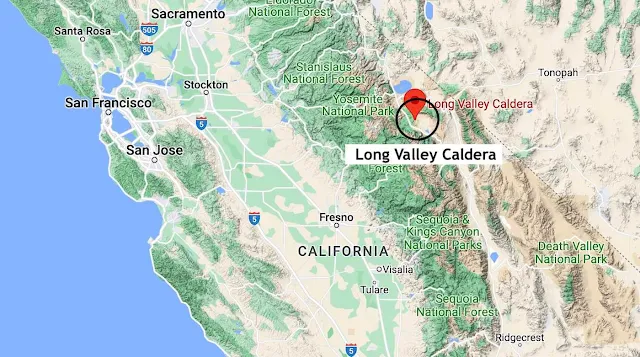Long Valley Caldera - California
The Long Valley Caldera is a large volcanic depression in eastern California, located about 200 miles (320 kilometers) east of San Francisco. It is one of the largest calderas in the United States, measuring about 20 miles (32 kilometers) long and 11 miles (18 kilometers) wide. The caldera is up to 3,000 feet (910 meters) deep.
The Long Valley Caldera was formed about 760,000 years ago by a massive volcanic eruption that ejected about 600 cubic kilometers (150 cubic miles) of magma. The eruption collapsed the roof of the magma chamber, creating the caldera.
The Long Valley Caldera is considered an active volcano, exhibiting ongoing hydrothermal activity and recurrent earthquakes. Despite the presence of these signs, the caldera has not erupted in recent times, with the most recent significant event occurring approximately 1,000 years ago. However, the potential for future eruptions remains, making the caldera a closely monitored volcanic region.
The caldera's landscape is characterized by a diverse array of geological features, including resurgent domes, hot springs, geothermal vents, and glacial moraines. These features reflect the caldera's complex geological history and ongoing volcanic activity. The area also supports a rich ecosystem, with diverse plant and animal species inhabiting its varied habitats.
 |
| Long Valley Caldera California map |
The key features of the Long Valley Caldera:
Resurgent dome: A large dome-shaped uplift that is thought to be caused by a rising magma intrusion beneath the caldera floor.
Crater Lake: A small, crater-shaped lake located near the center of the caldera.
Hot springs and fumaroles: Numerous hot springs and fumaroles, which release hot water and gas, are found throughout the caldera.
Geothermal power plants: Three geothermal power plants harness the heat from the underlying magma to generate electricity.
Despite the potential hazards, the Long Valley Caldera is an important part of the natural landscape of eastern California.
.jpg) |
| Cross-section through Long Valley Caldera formation |

%20(1).webp)






